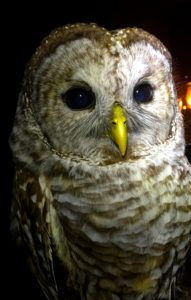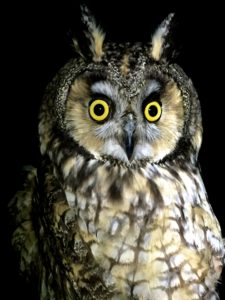It’s starting to feel like spring on our little peninsula, and we finally caught some big owls!


Every time we catch a bird in our mist-nets, big or small, we attach a silver ring to its right leg with a unique number—this is the ‘band’. All of these numbers are stored in a huge database, and when a bird is caught with a band on its leg, the bander can report a sighting of the animal and see where it was originally banded. This kind of data is very powerful for tracking movements of individual birds, and we can discover lots of cool information from it. Where do our owls migrate to and from? How do they disperse after they’re born? Do they return to their breeding grounds, or travel elsewhere? How long do they live? How many birds survive through their first winter? Second?
When we catch a bird in the net that has a band on it, we refer to it as a foreign recapture. These birds are some of the most exciting, but we don’t see them very often. Fortunately, we seem to be catching quite a few birds with bands already on them: we’re up to a total of 11 foreign recaptures out of 116 saw-whets.
A majority of the foreign recaptures we’ve caught were from the UP, some banded by Whitefish Point Bird Observatory, and even some returning MSRW birds (banded by Ed or Selena)! We also caught a bird that was originally banded in Ontario, one from New Hampshire, and one from Yellowwood State Forest in Indiana. We can also say that one of the birds is, at the least, going to turn five years old this year, and another will be four. We normally cannot age a bird after its third year, so to know definitively that these birds are that old is really neat!
Now, onto the numbers. We caught our first Long-eared owl right at the start of April, which was earlier than expected. Since then, we have been trying to call the birds in using a speaker that plays the Long-eared call, but it hasn’t pulled in too many birds yet. We caught two more Long-eareds early in the morning on 14 April, and were lucky enough to catch two male Barred Owls on 12 and 14 April, both a bit before midnight.
We’ve also seen a steady trickle of Saw-whets: low numbers, but we hadn’t gotten completely skunked until Wednesday night, when we had a very hopeful Audubon group out for a visit—go figure! We did get good looks at an adult Bald Eagle, though, and the sunset and Northern Lights were absolutely beautiful, so hopefully everyone had a good time.
Here are the day-by-day numbers:
|
31 March |
2 Northern Saw-whet |
|
1 April |
9 Northern Saw-whet, 1 Long-eared |
|
2 April |
16 Northern Saw-whet |
|
3 April |
NO BANDING |
|
4 April |
10 Northern Saw-whet |
|
5 April |
5 Northern Saw-whet |
|
6 April |
1 Northern Saw-whet |
|
7 April |
3 Northern Saw-whet |
|
8 April |
2 Northern Saw-whet (partial weather night) |
|
9 April |
NO BANDING |
|
10 April |
2 Northern Saw-whet (partial weather night) |
|
11 April |
3 Northern Saw-whet |
|
12 April |
2 Northern Saw-whet, 1 Barred |
|
13 April |
1 Northern Saw-whet, 2 Long-eared |
|
14 April |
2 Northern Saw-whet, 1 Barred |
|
15 April |
0 |
|
16 April |
1 Northern Saw-whet |
|
Season Total: |
116 Northern Saw-whet, 3 Long-eared, 1 Barred |
The spring migrants are moving in, too: we’ve been hearing lots of cool things right at dawn, from Eastern Phoebes to Sandhill Cranes, Winter Wrens, Northern Flickers… And the Golden-crowned Kinglets have started singing! The American Woodcocks are going strong, and we even found a Blue-spotted Salamander. So if the owls are slow, we still have some great springtime life to keep us entertained.
Wishing you all a great weekend!
